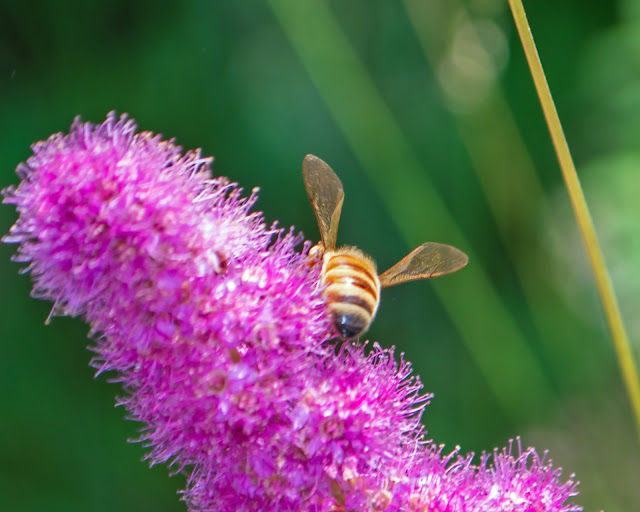It has been a poor year for little beasties, the insects and wormies and garden crustaceans, the bees and the butterflies, the showy orange underwing moths; there were no cabbage white larvae eating my nasturtiums, just the deer. Forest trails were devoid of banana slugs. Moving plant pots in the garden exposed one or two sowbugs, rarely more. The annual summer invasion of ants through a crack behind my kitchen window failed to materialize. And the spiders, oh the poor, hungry spiders; they patrolled empty webs, stayed tiny, and guarded few new families.
Whether the cause is climate change, here showing up as dry weather, or the increasing pollution of our air and water, or our ongoing destruction of habitat, I can't tell. All of the above, maybe.
Whatever the cause, I'm missing the spiders. Cellar spiders arrange their webs in the corners of the carport, and, indoors, along the edges of the ceiling and under plant stands. But they're all tiny, almost transparent; some I've seen are only recognizable by a sudden sense of movement. Outside my door, a couple of fat house spiders, Steatoda sp., hung around for a while; one tried to raise a family, but I never found spiderlings. There's an undersized giant house spider that does her rounds in my bedroom, finding a cricket or two, maybe a stray crane fly. I did see a jumping spider in my garden once. Once.
And now it's October. Or Arachtober, as I know it. The time when several hundred spider lovers from around the world post our year's crop of spider photos to the group pool, (go look) one a day, then the last week, two a day, and three for Hallowe'en; some 40 photos each. And this year, I doubt that I'll make the count. There will be a few finds this month; it's the time to look for cross spiders, before the rains wash away their webs. But last week's sorting of photos turned up only 17 spiders.
(It's close to midnight. In desperation, I just went out to the carport with a flashlight and searched every crack. I found two very small cellar spiders and one tiny house spider eating a young sowbug. And a fragment of a spider molt. I'll take the camera out in daylight to see if they're still there.)
Still, with the help of a friend who scouted some out for me, and held a flashlight on a couple in deep shade, I've been able to add a couple of cross spiders, Araneus diadematus, to the Arachtober pool. These:
 |
| Female, in characteristic pose, head down. |
 |
| Trapeze artist |
 |
| Brownie on the edge of the deck. |
About that first photo, I'll discuss some of the anatomy tomorrow.
~~~~~~~~~~~~
Ha sido un año pobre con respeto a los animalitos; los insectos, los gusanitos, los crustáqueos terrestres en nuestros jardines, las abejas, las mariposas, esas mariposas nocturnas con las alas secundarias anaranjadas; ningún larva de las mariposas "blanquita de la col" se comió las hojas de mis capuchinas; eso lo hicieron los venados. En los caminos entre el bosque, no aparecieron las babosas Ariolimax. Al mover las macetas en el jardín, solo salían a la vista una o dos cochinillas, casi nunca más. La invasión anual de hormigas que entran por una rendija tras la ventana de mi cocina no se produjo. Y las arañas, ah, esas pobres arañas hambrientas, cuidaban sus telarañas vacías, dejaban de crecer, no produjeron familias.
Sea por causa del cambio de clima (aquí expresado por la falta de agua), o de la contaminación del ambiente, o por nuestra persistente destrucción de habitat, no lo sé. Puede ser todo en conjunto.
Sea lo que sea, extraño las arañas. Las arañas fólcidas arreglan sus telarañas en las esquinas y bajo soportes para plantas. Pero todas son miniaturas, y casi transparentes; algunas apenas se reconocen por la idea de movimiento. Afuera de mi puerta, dos arañas caseras Steatoda sp. duraron unos dias; una trató de formar una familia, pero nunca encontré sus arañitas infantiles. Hay una araña "gigante" pero no tan grande, que se ocupa en vigilar mi recámara, encontrando algunos grillos. Vi una araña saltadora en mi jardín una vez este año. Una sola vez.
Y estamos en octubre. O como lo llamamos, Aractober, el mes de las arañas. Es el mes cuando varios cientos de amantes de las arañas de todo el mundo suben fotos al grupo Flickr,
#Arachtober, (haz clic), subiendo una foto por dia, dos en la cuarta semana, y tres el Dia de los Muertos, una 40 fotos cada quien. Y este año, creo que no voy a tener suficiente para terminar el mes. Habrá una que otra nueva foto este mes; es la temporada de las arañas
Araneus diadematus, mientras no lleguen las lluvias fuertes. Pero al revisar mis fotos la semana pasada, encontré solo 17 fotos para subir al grupo.
(Es medianoche. Se me ocurrió ver si podía encontrar arañas en mi cochera a estas horas. Con una linterna busqué en todos los rincones. Encontré dos arañas fólcidas, muy pequeñas, y una arañita casera también muy chica comiéndose una cochinilla joven. Y un pedazo de una muda. Mañana, cuando hay luz, saco la cámara.)
De todas maneras, con la ayuda de una amiga que fue en búsqueda de arañas y detuvo una linterna para alumbrar unas que tienen sus telarañas en sombra densa, pude subir fotos de dos Araneus diadematus al grupo de Arachtober.
Fotos:
- Una hembra en su postura característica. Haré comentario sobre ésta mañana.
- La misma, haciéndose una trapecista.
- Otra, la misma especie,pero café, mostrando el diseño de su abdomen.











